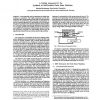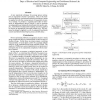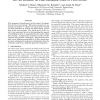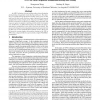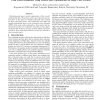DAC
1991
ACM
14 years 10 months ago
1991
ACM
-Conventionallyself-test hardware is added after synthesis is completed. For highly sequential circuits like controllersthis design method eitherleads to high hardware overheadsor ...
ISLPED
1997
ACM
14 years 10 months ago
1997
ACM
A new statistical technique for average power estimation in sequential circuits is presented. Due to the feedback mechanism, conventional statistical procedures cannot be applied ...
ISLPED
1997
ACM
14 years 10 months ago
1997
ACM
New measures of peak power in the context of sequential circuits are proposed. This paper presents an automatic procedure to obtain very good lower bounds on these measures as wel...
EURODAC
1995
IEEE
14 years 10 months ago
1995
IEEE
: We present a new, dynamic algorithm for test sequence compaction and test cycle reduction for combinationaland sequential circuits. Several dynamic algorithms for compaction in c...
DAC
1995
ACM
14 years 10 months ago
1995
ACM
Abstract A new method for power estimation in sequential circuits is presented that is based on a statistical estimation technique. By applying randomly generated input sequences t...
ICCAD
1994
IEEE
14 years 11 months ago
1994
IEEE
This paper presents a new method of selecting scan
ipops (FFs) in partial scan designs of sequential circuits. Scan FFs are chosen so that the whole circuit can be partitioned in...
DAC
1996
ACM
14 years 11 months ago
1996
ACM
In this paper, we describe a technique for power reduction in sequential circuits. Existing signals in the circuit are used to selectively disable some of the registers so that a ...
DAC
1997
ACM
14 years 11 months ago
1997
ACM
An ATPG technique is proposed that reduces heat dissipation during testing of sequential circuits that have full-scan. The objective is to permit safe and inexpensive testing of l...
DATE
1997
IEEE
14 years 11 months ago
1997
IEEE
The paper proposes a novel approach in an attempt to solve the test problem for sequential circuits. Up until now, most of the classical test pattern techniques use a number of al...
DATE
1999
IEEE
14 years 11 months ago
1999
IEEE
Estimating peak power involves optimization of the circuit's switching function. We propose genetic spot expansion and optimization in this paper to estimate tight peak power...
